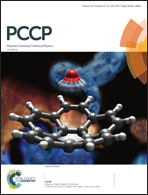Drop spreading on a superhydrophobic surface: pinned contact line and bending liquid surface†
Abstract
In this study, we employ molecular dynamics (MD) simulations to probe the spreading of a drop on a superhydrophobic (SH) surface. The SH surface consists of nanopillars and the drop spreads while being in the Cassie–Baxter (CB) state on the nanopillared surface. Most remarkably, unlike the spreading on non-SH surfaces, we witness that the spreading on SH surfaces is not dominated by the motion of the three-phase contact line (TPCL). Rather, the TPCL remains pinned at the edge of a nanopillar and the spreading is ensured by the liquid surface or the liquid–vapor interface (of this pinned TPCL) bending down and wetting the solid adjacent to the TPCL. Such bending may actually enforce a progressive temporal increase in the instantaneous local contact angle eventually making it equal to or more than 180°. This is in sharp contrast to the classical spreading dynamics, where, with the spreading being dictated by the TPCL motion, the local contact angle always decreases with time. We carry out simulations where the solids supporting the nanopillars have vastly different wettabilities; however, this principle of bending-driven spreading is invariably witnessed. In fact, given the recent experimental study on the rolling of drops on SH surfaces manifesting exactly identical liquid-surface-bending-driven drop motion, we can infer that regardless of the drop size (e.g., nanoscopic or millimetric) or the nature of drop motion (spreading or rolling), the motion of drops in the CB state on SH surfaces is universally driven by the bending of liquid surfaces and not by the motion of the TPCL.



 Please wait while we load your content...
Please wait while we load your content...